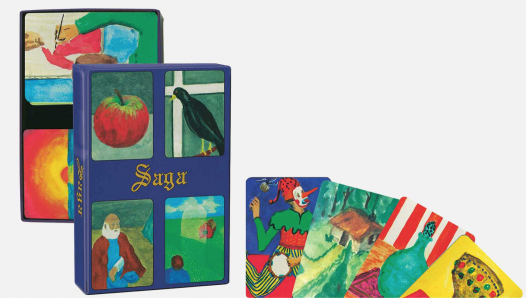Story cards
Recommended age: all
Objectives
- To encourage imagination and practise spontaneous speaking
- To generate vocabulary (practise grammar)
- To give the teacher time to decide what to do for the rest of the lesson.
(This is not intended as a joke: teaching is a tough life!)

There are many cards available to encourage students to develop stories of their own: just google storytelling cards to see. These range from suggestions for homemade cards to commercial products of varying complexity (search Amazon for those).
My preference is two of the sets produced by OH Cards, Saga and 1001. This may be because my first encounter with such cards was in a workshop led by Moritz Egetmeyer of OH Cards, but their simplicity (beautifully produced pictures without any text) makes them easily adaptable for different activities. OH produce a variety of other decks.
But whatever type of cards you choose to use, having a set in your schoolbag is a great standby for those times when a lesson needs to be improvised out of thin air.
Procedure
There are many ways of using such cards, and you will doubtless find new activities evolving. Here are four to start with (I suspect I met the first three in the Moritz Egetmeyer workshop).
Small-group story creation
-
- Students work in small groups, each group with part of a pack of cards face-down on the desk. First student takes top card, places it so all can see and starts telling a story incorporating the picture: Once upon a time (or some such beginning).
- When the first student feels enough has been told (I tell the class around a minute is probably a good time), the second student takes the next card, places it by the first and continues the same story.
- Groups continue placing cards to develop their stories. When the cards are used up, it is simple to exchange one group’s cards for those of a neighbouring group to enable the story to continue.
- As a teacher, I can end the activity by telling the class: The next card finishes the story.
Beginning – Middle – End
-
- Students work with a partner. They take (or are given) three unseen cards at random from the pack.
- Students are told they will place cards in a row face up and then will have about three minutes to create their own story, incorporating the first card into the beginning, the second into the middle, the third into the end of the story.
- The cards are turned over and the story begins.
Missing picture
-
- Students work with a partner. The desk they are sitting at must be cleared of all objects.
- They take (or are given) one card.
- Students are told the entire area of their empty desk is a large picture, of which the card is just a small piece. Together they decide where the card is in relation to the rest of the picture, and proceed to describe the larger picture.
Class story creation
-
- Taking six cards to create a story with the whole class could be used as a variation of the activity described in the Woman and the Skeleton.
(That page also shows how art work can be incorporated with the language).
- Taking six cards to create a story with the whole class could be used as a variation of the activity described in the Woman and the Skeleton.
During and after
During all small group and partner activities the teacher can circulate to help with queries about vocabulary (occasionally even grammar). However, encourage groups not to allow language uncertainty to hinder communication.
Guns and explosives
With such activities there may be a problem, especially with young teenage boys, that guns, explosives, etc. feature heavily in their plots. Any issues of censorship aside, my experience suggests that such elements often have a negative effect by blocking the development of any further plot. If I suspect it may be necessary, a brief explanation that such elements are better left out is usually sufficient.
Writing
An obvious follow-up can be to write the story. Such free writing can be directed by using the Language Checklist.
Reading
Subsequently the written work is laid out on the desks and students are given a few minutes to walk around and read.
They can be encouraged to underline examples of good vocabulary and grammar they see in others’ work. You may also wish to encourage them to look for examples of favourite mistakes (see here for more about using a favourite mistake list).
Discussing such examples of good (and less good) language is an excellent way of consolidating grammar and vocabulary. That it is based on the students’ own writing is, to my mind, infinitely preferable to textbook teaching.
Such reading-around is generally a useful way of giving students a chance to read and then discuss what others are producing for homework. I have found it especially valuable with essays written by older students.
More information
An article by Dutch storyteller Marco Holmer on his work with story cards.
For more on my methodology, read Telling stories in the classroom: basing language teaching on storytelling.
Go here for tales to watch
Go here for a list of all tales included on this site
Go here to receive an e-mail notification when new tales are added
Permission to tell outlines my views on copyright
For those who are teachers: Telling stories in the classroom: basing language teaching on storytelling
